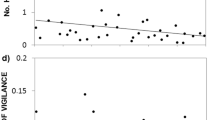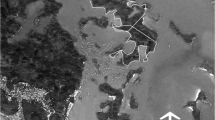Summary
The effects of sex and seasonal changes in food abundance on foraging behavior was studied in squirrel monkeys (Saimiri oerstedi) in Costa Rica over an eleven-month period. Females searched for and ate food at significantly greater frequencies than did males throughout the study. The frequency of the specific foraging techniques used occasionally differed significantly within seasons, but not across the study period. Few differences were found in the foraging behaviors of nonreproductive sexually mature females compared to females that were pregnant or lactating. The major exception was that during the month following parturition reproductive females foraged for flowers and fruits more frequently than did non-reproductive females. The reduction of time spent by males in foraging activities gives them more time for other activities, especially anti-predator vigilance. Foraging techniques and the proportions of different food types in the diet changed seasonally. Foraging for arthropods was most frequent in the season when arthropod abundance was lowest, resulting in the amount of time spent eating arthropods to vary less across the seasons. Fruits and flowers were not eaten in a direct relationship to availability, but were used more than expected relative to availability when arthropod abundance was reduced. Individuals were more dispersed when foraging compared to other activities. Overall, there was little evidence of any direct foraging benefits for a squirrel monkey from being social.
Similar content being viewed by others
References
Alexander RD (1974) The evolution of social behavior. Ann Rev Ecol Syst 5:325–383
Altmann J (1974) Observational study of behaviour: sampling methods. Behaviour 69:227–267
Altmann SA, Altmann J (1970) Baboon ecology: African field research. University of Chicago Press, Chicago
Baldwin JD, Baldwin JI (1981) The squirrel monkeys, genus Saimiri. In: Coimbra-Filho AF, Mittermeier RA (eds) Ecology and behavior of neotropical primates. Academia Brasiliera de Ciencias, Rio de Janeiro, pp 277–330
Boinski S (1985) The status of Saimiri oerstedi in Costa Rica. Primate Conservation 6:15–16
Boinski S (1986) The ecology of squirrel monkeys in Costa Rica. PhD thesis, University of Texas at Austin
Boinski S (1987a) Mating patterns in squirrel monkeys (Saimiri oerstedi): implications for seasonal sexual dimorphism. Behav Ecol Sociobiol 21:13–21
Boinski S (1987b) Birth synchrony in squirrel monkeys (Saimiri oerstedi): a strategy to reduce neonatal predation. Behav Ecol Sociobiol 21:393–400
Boinski S (1988) Habitat use in Costa Rican squirrel monkeys. Folia Primatol (in press)
Boinski S, Fowler NL (1988) Seasonal patterns in a tropical lowland forest. Biotropica (in press)
Boinski S, Fragaszy DM (1988) The ontogeny of foraging in squirrel monkeys (Saimiri oerstedi). Anim Behav (in press)
Boinski S, Scott PE (1988) Association of birds with monkeys in Costa Rica. Biotropica 20:136–143
Boinski S, Timm RM (1985) Predation by squirrel monkeys and double-toothed kites on tent-making bats. Am J Primatol 9:21–28
Bronson FH (1985) Mammalian reproduction: an ecological perspective. Biol Reprod 32:1–26
Brown JL (1975) The evolution of behavior, Norton, New York
Cheney DL (1987) Interactions and relationships between groups. In: Smuts BB, Cheney DL, Seyfarth RM, Wrangham RW, Struhsaker TT (eds) Primate societies. University of Chicago Press, Chicago, pp 267–281
Clark DA (1980) Age- and sex-dependent foraging strategies of a small mammalian omnivore. J Anim Ecol 49:549–564
Clutton-Brock TH (1977) Some aspects of intraspecific variation in feeding and ranging behaviour in primates. In: Clutton-Brock TH (ed) Primate ecology: studies of feeding and ranging behaviour in lemurs monkeys and apes. Academic Press, London, pp 539–556
Clutton Brock TH, Harvey PH (1978) Mammals, resources and competitive strategies. Nature 273:191–195
Clutton-Brock TH, Guiness FE, Albon SD (1982) Red deer: the behaviour and ecology of two sexes. University of Chicago Press, Chicago
Cody ML (1971) Finch flocks in the Mojave desert. Theor Popul Biol 2:141–158
Cody MI (1974) Competition and the structure of bird communities. Princeton University Press, Princeton
Coe CL, Rosenblum LA (1978) Annual reproductive strategy of the squirrel monkey (Saimiri sciureus). Folia Primatol 29:19–42
Coe CL, Smith ER, Levine S (1985) The endocrine system of the squirrel monkey. In: Rosenblum LA, Coe CL (eds) Handbook of squirrel monkey research. Plenum Press, New York, pp 169–190
Crook JH (1965) The adaptive significance of avian social organization. Symp Zool Soc Lond 14:181–218
Dittus WPJ (1977) The social regulation of population density and age-sex distribution in the toque monkey. Behaviour 63:281–322
DuMond FV, Hutchinson TC (1967) Squirrel monkey reproduction: the “fatted” male phenomenon and seasonal spermatogenesis. Science 197:215–223
Fairbanks LA, Bird J (1978) Ecological correlates of interindividual distance in the St Kitts vervet (Cercopithecus aethiops sabaeus). Primates 19:605–614
Gautier-Hion A (1980) Seasonal variations in diet related to species and sex in a community of Cecopithecus monkeys. J Anim Ecol 49:237–269
Gill FB, Wolf LL (1975) Economics of feeding territoriality in the golden-winged sunbird. Ecology 56:333–345
Goss-Custard JD (1985) Foraging behaviour of wading birds and the carrying-capacity of estuaries. In: Sibly RM, Smith RH (eds) Behavioral ecology: ecological consequences of adaptive behaviour. Blackwell, Oxford, pp 169–188
Gradwohl JA, Greenberg R (1984) Search behavior of the checker-throated antwren foraging in aerial leaf litter. Behav Ecol Sociobiol 15:281–285
Hamilton WD (1971) Geometry for a selfish herd. J Theor Biol 31:295–311
Hershkovitz P (1984) Taxonomy of squirrel monkeys genus Saimiri (Cebidae, Platyrrhini): a preliminary report with a description of a hitherto unnamed form. Am J Primatol 7:155–210
Hinde RA; ed (1983) Primate social relationships: an integrated approach. Sinauer, Sunderland
Holdridge LR (1967) Life zone ecology. Tropical Science Center, San José, Costa Rica
Holmes RT (1986) Foraging patterns of forest birds: male-female differences. Wilson Bull 98:196–213
Janson CH (1985) Aggressive competition and individual food consumption in wild brown capuchin monkeys (Cebus apella). Behav Ecol Sociobiol 18:125–139
Janzen DH; ed (1983) Costa Rican natural history. University of Chicago Press, Chicago
Jarman MV, Jarman PJ (1973) Daily activity patterns of impala. E Afr Wildlife J 11:75–85
Krebs JR (1979) Feeding strategies and their social significance. In: Marler P, Vandenburg J (eds) Handbook of behavioral neurobiology: social behavior and communication. Plenum Press, New York, pp 225–270
Lack D (1950) The breeding seasons of European birds. Ibis 92:288–316
Lancaster JB, Lee RB (1965) The annual reproductive cycle in monkeys and apes. In: Devore I (ed) Primate behavior: field studies of monkeys and apes. Holt, New York, pp 486–513
Leigh E Jr, Rand AS, Windsor DM; eds (1982) The ecology of a tropical forest: seasonal rhythms and long-term changes. Smithsonian Institution, Washington
MacArthur RH, Pianka ER (1966) On optimal use of a patchy environment. Am Nat 100:603–609
Mendoza SP, Lowe EL, Resko JA, Levine S (1978) Seasonal variations in gonadal Hormones and social behavior in squirrel monkeys. Physiol Behav 20:515–522
Miller RS (1967) Pattern and process in competition. Adv Ecol Res 4:1–74
Parker WS, Brown W (1980) Comparative ecology of two colubrid snakes, Masticophis t. taeniatus and Pituophis melanoleucus deserticola, in northern Utah. Milwaukee Public Museum Publ Biol Geol, vol 7
Perrigo G, Bronson FH (1985) Sex differences in the energy allocation strategies of house mice. Behav Ecol Sociobiol 17:297–302
Pienkowski MW (1983) Changes in the foraging pattern of plovers in relation to environmental factors. Anim Behav 31:244–264
Pyke GH, Pulliam HR, Charnov EL (1977) Optimal foraging: a selective review of theory and tests. Quart Rev Biol 52:137–154
Robinson JG (1981) Spatial structure in foraging groups of wedge-capped capuchin monkeys (Cebus nigrivattatus). Anim Behav 29:1036–1056
Rodman PS (1977) Feeding behaviour of orang-utans of the Kutai Nature Reserve, East Kalimantan. In: Clutton-Brock TH (ed) Primate ecology: studies of feeding and ranging behaviour in lemurs, monkeys and apes. Academic Press, London, pp 383–413
Schaik van CP (1983) Why are diurnal primates living in groups? Behaviour 87:120–143
Schaik van CP, Hoof van JARAM (1983) On the ultimate causes of primate social systems. Behaviour 85:91–117
Schaik van CP, Noordwijk van MA, Boer de RJ, Tonkelaar den I (1983) The effect of group size on time budgets and social behavior in wild long-tailed macaques (Macaca fascicularis). Behav Ecol Sociobiol 13:173–182
Schoener TW (1971) Theory of feeding strategies. Ann Rev Ecol Syst 2:369–404
Selander TW (1966) Sexual dimorphism and differential niche utilization in birds. Condor 68:113–151
Sokal RR, Rohlf FJ (1981) Biometry, 2nd edn. Freeman, San Francisco
Terborgh J (1983) Five New World primates: a study in comparative ecology. Princeton University Press, Princeton
Terborgh J, Janson CH (1986) The socioecology of primate groups. Ann Rev Ecol Syst 17:111–135
Thorington RW (1985) The taxonomy and distribution of squirrel monkeys (Saimiri). In: Rosenblum LA, Coe CL (eds) Handbook of squirrel monkey research. Plenum Press. New York, pp 1–34
Toft CA (1984) Activity budgets in two species of bee flies (Lordotus: Bombyliidae, Diptera): a comparison of species and sexes. Behav Ecol Sociobiol 14:287–296
Whitten PL (1983) Diet and dominance among female vervet monkeys (Cercopithecus aethiops). Am J Primatol 5:139–159
Wrangham RW (1980) An ecological model of female-bonded primate groups. Behaviour 75:262–300
Wright PC (1984) Parental care in Aotus trivirgatus and Callicebus moloch. In: Small MF (ed) Female primates: studies by woman primatologists. Liss, New York, pp 59–75
Author information
Authors and Affiliations
Rights and permissions
About this article
Cite this article
Boinski, S. Sex differences in the foraging behavior of squirrel monkeys in a seasonal habitat. Behav Ecol Sociobiol 23, 177–186 (1988). https://doi.org/10.1007/BF00300352
Received:
Accepted:
Issue Date:
DOI: https://doi.org/10.1007/BF00300352




